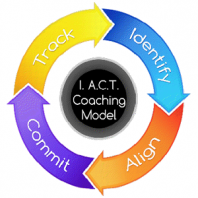A Coaching Model Created by Claire Wong
(Executive Coach, UNITED STATES)

I become because I act. – Claire Wong
To have meaningful coaching, both the coach and the client must have a clear vision of the expected outcome. When the client is able to identify what he really wants, coaching efforts become focused. To clearly identify his goals, the client usually needs to go through a process of examination, reflection and prioritization of various aspects of his life. Sometimes, the client may have to clarify his values and underlying beliefs before he can arrive at a clear goal.
The client’s values and underlying beliefs always influence his perception and thinking during the coaching sessions. Using thorough examinations, reflections and prioritizations, the client can identify and reinforce his core values and beliefs. As values and beliefs drive behaviors that affect outcomes, once the client’s values and beliefs are aligned with his goal, a solid foundation is established to support the client in his journey. When the conflicts between the client’s goal and his core values and beliefs are resolved, the distractions and discomforts arising from such conflicts will be eliminated. The client will then be able to focus on committing to his goal and using all his energy for creating action.
Coaching happens only when action is taken. Commitment to his goal and action plan is the first and most important action for the client to take. Then, the client needs to carry out other actions in his plan in order to achieve his goal.
Tracking is necessary to ensure that all intended actions are taken in a timely fashion. It can uncover a delay in action and prompt the client to examine and address the cause for the delay. This enables the client to stay on track. Tracking also reveals changes that require the client’s further attention so that he can remain in action. Successful actions noted along the way can provide the client with acknowledgements and validations.
My 4 step cycle coaching model is aimed at moving the client to action and achieving his goal through identification, alignment, commitment and tracking.
The initial stage of coaching is usually one of self exploration and discovery. The client may express his intentions and desires at length. The key at this stage is to help the client identify what is truly important to him.
Identification of the client’s goal is paramount. However, for effective coaching, a comprehensive picture which covers other aspects as well is most helpful.
Upon the completion of the identification process, which process may call for multiple clarifications through repeated examinations, reflections and prioritizations, the client will have a clear vision of the best possible outcome.
Through clarification in the identification exercise, the client can also understand what to expect from coaching.
When the client’s goals are not in alignment with his values and beliefs, the client will feel out of balance. Being out of balance is uncomfortable and distracting. It is natural for the client to use his efforts to get rid of his anxiety and regain his balance above all else. If not attended, such distractions wear on the client’s commitment, delay his actions towards the goal and disrupt his growth momentum.
Similarly, multiple conflicting goals pull the client in different directions and sabotage his efforts and focus. It is crucial that the client prioritizes and aligns his various conflicting goals before moving forward.
As soon as the client’s goals are aligned with who he actually is, he will be engaged at the most authentic level. The client will feel in sync and ready to take on challenges.
The client may have the clearest picture of the best possible outcome but nothing happens until the client commits. When commitment is present, actions will be taken without excuses.
Once the client feels that his goals, values and beliefs are connected, commitment becomes easier and living the commitment becomes a habit. When committed, taking action, building support structures and seeing new opportunities will come spontaneously to the client.
Tracking provides accountability which is an important aspect of coaching. It provides a reality check and generates feedback for the client.
Changes noted through tracking will cause the client to further clarify his situation by examining, reflecting and prioritizing. Tracking provides the client with an opportunity to make deeper connections and consider new actions. It may result in goals being modified, additional support structures being developed and time lines being adjusted.
Successes acknowledged through tracking are great momentum boosters for the client.
As the client’s growth is not always a linear progression, the client may need to go through the cycle of identification, alignment, commitment and tracking a few times in order to achieve meaningful results.
Ultimately, coaching is about being in action. My I.A.C.T. coaching model is about moving the client to action, keeping the client on track and supporting the client with momentum. After all, I become because I act.